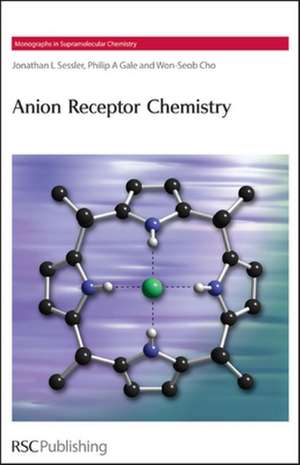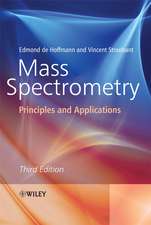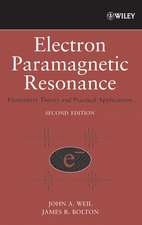Anion Receptor Chemistry: Rsc: Monographs in Supramolecular Chemistry, cartea 8
Autor Jonathan L. Sessler, Philip A. Gale, Won-Seob Choen Limba Engleză Hardback – 31 mar 2006
Anion recognition plays a critical role in a range of biological processes, and a variety of receptors and carriers can be found throughout the natural world. Chemists working in the area of supramolecular chemistry have created a range of anion receptors, drawing inspiration from nature as well as their own inventive processes. This book traces the origins of anion recognition chemistry as a unique sub-field in supramolecular chemistry while illustrating the basic approaches currently being used to effect receptor design. The combination of biological overview and summary of current synthetic approaches provides a coverage that is both comprehensive and comprehensible. First, the authors detail the key design motifs that have been used to generate synthetic receptors and which are likely to provide the basis for further developments. They also highlight briefly some of the features that are present in naturally occurring anion recognition and transport systems and summarise the applications of anion recognition chemistry. Providing as it does a detailed review for practitioners in the field and a concise introduction to the topic for newcomers, Anion Receptor Chemistry reflects the current state of the art. Fully referenced and illustrated in colour, it is a welcome addition to the literature.
Din seria Monographs in Supramolecular Chemistry
- 14%
 Preț: 1307.70 lei
Preț: 1307.70 lei - 14%
 Preț: 1212.70 lei
Preț: 1212.70 lei - 14%
 Preț: 1296.91 lei
Preț: 1296.91 lei - 14%
 Preț: 1218.11 lei
Preț: 1218.11 lei - 14%
 Preț: 1215.98 lei
Preț: 1215.98 lei - 9%
 Preț: 1240.97 lei
Preț: 1240.97 lei - 14%
 Preț: 1248.32 lei
Preț: 1248.32 lei - 14%
 Preț: 1388.15 lei
Preț: 1388.15 lei - 14%
 Preț: 851.74 lei
Preț: 851.74 lei - 14%
 Preț: 1386.51 lei
Preț: 1386.51 lei - 14%
 Preț: 1155.02 lei
Preț: 1155.02 lei - 14%
 Preț: 1389.84 lei
Preț: 1389.84 lei - 14%
 Preț: 1227.21 lei
Preț: 1227.21 lei - 14%
 Preț: 1389.84 lei
Preț: 1389.84 lei - 14%
 Preț: 947.15 lei
Preț: 947.15 lei - 14%
 Preț: 1224.27 lei
Preț: 1224.27 lei - 11%
 Preț: 687.59 lei
Preț: 687.59 lei - 14%
 Preț: 1208.50 lei
Preț: 1208.50 lei - 14%
 Preț: 1230.53 lei
Preț: 1230.53 lei - 14%
 Preț: 942.75 lei
Preț: 942.75 lei - 9%
 Preț: 613.88 lei
Preț: 613.88 lei - 9%
 Preț: 1170.08 lei
Preț: 1170.08 lei - 9%
 Preț: 1169.42 lei
Preț: 1169.42 lei - 9%
 Preț: 1240.83 lei
Preț: 1240.83 lei - 9%
 Preț: 1170.73 lei
Preț: 1170.73 lei - 9%
 Preț: 936.20 lei
Preț: 936.20 lei
Preț: 1128.59 lei
Preț vechi: 1312.32 lei
-14% Nou
Puncte Express: 1693
Preț estimativ în valută:
215.95€ • 226.08$ • 178.69£
215.95€ • 226.08$ • 178.69£
Carte tipărită la comandă
Livrare economică 05-19 aprilie
Preluare comenzi: 021 569.72.76
Specificații
ISBN-13: 9780854049745
ISBN-10: 0854049746
Pagini: 430
Dimensiuni: 155 x 234 x 28 mm
Greutate: 0.8 kg
Editura: Royal Society Of Chemistry
Seria Monographs in Supramolecular Chemistry
Locul publicării:United Kingdom
ISBN-10: 0854049746
Pagini: 430
Dimensiuni: 155 x 234 x 28 mm
Greutate: 0.8 kg
Editura: Royal Society Of Chemistry
Seria Monographs in Supramolecular Chemistry
Locul publicării:United Kingdom
Cuprins
PREFACE; CHAPTER 1; 1.1: Importance of Anions in the Modern World; 1.2: The Challenges of Anion Complexation; 1.3: Anions in Biological Systems; 1.4: Historical Overview of Synthetic Anion Receptor Chemistry; 1.5: Measurement Methods: Caveats and Limitations; 1.6: Summary Remarks; CHAPTER 2: Classic Charged Non-Metallic Systems; 2.1: Polyammoniums; 2.2: Quaternary Ammoniums; 2.3: Guanidiniums; 2.4: Amidiniums; 2.5: Imidazoliums; 2.6: Thiouronium; 2.7: Summary Remarks; CHAPTER 3: Protonated Expanded Porphyrins and Linear Analogues; 3.1: Introduction; 3.2: Cyclic Systems; 3.3: Linear Receptors; 3.4: Summary Remarks; CHAPTER 4: Neutral Non-Metallic Systems; 4.1: Amide-Based Anion Receptors; 4.2: Peptide-Based Receptors; 4.3: Urea-Based Anion Receptors; 4.4: Alcohol-Based Anion Receptors; 4.5: Hybrid Receptors; 4.6: Other Systems; 4.7: Summary Remarks; CHAPTER 5: Neutral Pyrrole Systems; 5.1: Introduction; 5.2: Cyclic Receptors; 5.3: Linear Receptors; 5.4: Summary Remarks; CHAPTER 6: Receptors for Ion Pairs; 6.1: Introduction; 6.2: Ditopic Receptors; 6.3: Cascade Complexes; 6.4: Receptors for Zwitterions; 6.5: Dual Host Extraction of Salts; 6.6: Summary Remarks; CHAPTER 7: Metal and Lewis Acid Based Receptors; 7.1: Lewis Acidic Receptors; 7.2: Metals as Organizers; 7.3: Other Anion Receptors Containing Metals; 7.4: Summary Remarks; CHAPTER 8: Sensors; 8.1: Introduction; 8.2: Devices that Employ Anion Selective Membranes; 8.3: Discrete Molecular Electrochemical Anion Sensors; 8.4: Discrete Molecular Optical Anion Sensors; 8.5: Displacement Assays; 8.6: Assays Based on Deaggregation Phenomena; 8.7: Summary Remarks; CHAPTER 9: Anion Controlled Assembly and Template-based Synthesis; 9.1: Introduction; 9.2: Halide Controlled Assemblies; 9.3: Oxyanion Directed Assemblies; 9.4: Polyfluoro-anion Directed Assemblies; 9.5: Summary Remarks; CHAPTER 10: Afterword
Recenzii
A highly readable, concise and up-to-date overview of the exciting, vibrant and rapidly growing field of anion coordination chemistry. As world leading practitioners in the area, the authors' enthusiasm for the subject matter comes across loud and clear.
Descriere
This book traces the origins of anion recognition as a unique sub-field in supramolecular chemistry, while illustrating the basic approaches used to effect receptor design.










